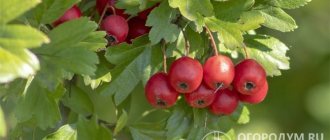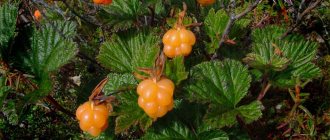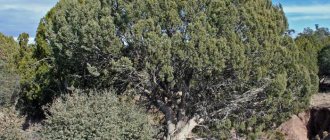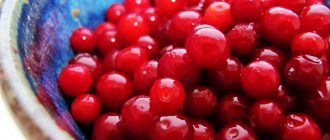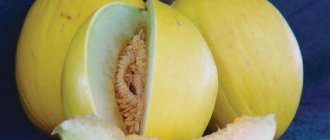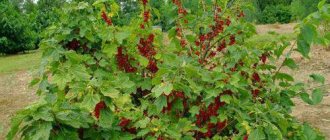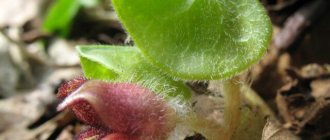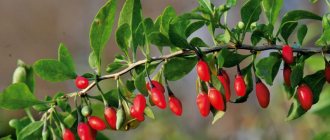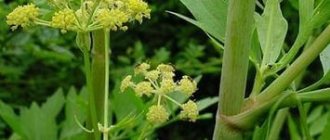Varieties
The Hawthorn genus has more than 380 species, as well as many forms and hybrids. But it is large-fruited garden crops that are in increasing demand, so the following representatives of the genus can most often be found in the open ground.
Hawthorn large-fruited
A shrub or small tree with thorns, the size of which varies from 4 to 12 centimeters. It enters the flowering phase in May-June, the fruits ripen towards the end of September, remain on the branches for a long time, and do not fall off. It blooms with white, pink or red flowers collected in thyroid inflorescences.
The fruits can have an oval, spherical or oblong shape. Their ovary does not occur every season, and their presence on the plant will completely depend on weather conditions. If the spring was rainy, then you should not expect fruiting on the bush this season.
The seedling will begin to bear fruit 5-8 years after rooting in the garden; the yield of an adult tree can reach up to 20 kilograms.
Hawthorn blood red
The species is represented by shrubs or trees, the height of which does not exceed 5 meters. The name of the plant is due to the color of its shoots - red or red-brown. The branches of the species are covered with hard spines. It blooms with white flowers in May-June.
The fruits ripen closer to September and are red oval berries with sweet and sour pulp and seeds inside. The species is distinguished by its winter hardiness, so it is suitable for growing in the Moscow region or Siberia.
Hawthorn softish
Trees, 6 to 8 meters high, may have one or more trunks. The shoots will be painted ash-gray, growing to form a tent-shaped crown. The branches are covered with thin spines, 3 to 9 centimeters long.
The green mass is ovoid in shape with a pointed apex. In autumn, the dark green color of the leaves changes to red-brown. The shrub blooms in May with white flowers collected in inflorescences.
The species is notable for its high yield rates; the fruits can reach 2 centimeters in length, are orange-red in color with juicy pulp inside.
Hawthorn pinnately cut
A species represented by shrubs or trees. The height of adult plants can reach 6 meters. In nature, it is found in China, Korea and eastern Russia, therefore in some sources it is called Far Eastern or Chinese.
Hawthorn is thornless, sometimes it has a few straight needles, 1-2 centimeters long. The bark of the trunk is dark gray in color; young shoots will be yellowish-gray.
The leaves of the crop are shiny, pinnately incised, ovate or oblong-ovate. The species blooms in May, the flowers are white, collected in inflorescences with bare stalks. The fruits are spherical or pear-shaped, up to 2 centimeters long. The color is bright red, they ripen from August to October.
Hawthorn pontica
A heat-loving culture, found naturally in Turkey, Crimea, and Central Asia. The cultivated species is in demand among gardeners due to the complete absence of thorns on the shoots, which greatly facilitates the harvesting process. In addition, among a large number of varieties, this particular species has the most fleshy fruits with a yellow color and apple flavor.
Also, the demand for Pontic hawthorn is due to its decorative appeal. Shrubs and trees look very impressive thanks to their slight pubescence, reminiscent of silver pollen on the green mass. The height of an adult plant can reach 5-6 meters.
Canadian hawthorn
Trees with a spreading crown grow up to 5-7 meters. The crop enters the flowering phase in May-June. The species blooms with white-pink flowers, fruiting occurs in August.
The yield is average, the fruits are spherical in shape. Can be painted orange, red or black.
Hawthorn pinnately cut
This variety has been grown in garden culture since the 19th century. It grows mainly in damp river valleys, and is found in the lower parts of mountain ranges in the Amur and Primorye regions. This variety of hawthorn can also be found in China and Korea. Very often, pinnathorn hawthorn grows in the undergrowth of oak trees and in thickets of various shrubs.
Cirrus hawthorn is a tree up to 6 meters high or a shrub. The pink flowers of the tree are collected in drooping corymbs. The crown of the tree is thick and spreading, the bark is dark gray. This variety of hawthorn has no thorns or very few of them. You can recognize the variety by its beautiful bright green leaves, which are quite large. The fruits of the pinnathorn hawthorn are bright red in color, dotted with small white warts. The variety blooms in June, the fruits ripen by September. The tree begins to bear fruit at the age of six.
The plant is light-loving and loves moist, nutritious soil. The species is very resistant to significant drops in air temperature, which allows it to be grown in culture almost everywhere.
Plants of this variety tolerate replanting well, can be pruned, and can grow and develop in polluted city conditions. Seed germination is very low - only 10%, so hawthorn is propagated by pinnate cuttings or root suckers. The tree is very decorative throughout the season and is widely used in the design of gardens and parks. This variety is considered the most decorative.
Landing
In order to have a beautiful and fruit-bearing crop in the garden, it is recommended to adhere to some rules regarding agricultural technology.
Landing dates
The optimal time for rooting hawthorn in open ground is spring - mid-April, however, planting work can also be carried out in the fall - in October.
The timing is adjusted taking into account the climatic characteristics of the region. For the Moscow region and the North-Western region, it would be more correct to plant in the spring 5-7 days later than the general recommendations, in the fall - closer to the beginning of October.
For southern latitudes, the timing shifts in the opposite direction - early planting is carried out in the spring, and in the fall the work is postponed until the end of October.
Selecting a location
The selection of a suitable option for placing a crop in the garden depends on the ultimate goals of its cultivation. If a shrub or tree is cultivated for harvesting, then it is best to stop at single plantings of 2-3 crops at a distance of 2.5-3 meters from each other, which will have a positive effect on pollination.
When using the plant for decorative purposes, group planting and the creation of a hedge are allowed. In this case, the step between seedlings should be about 0.5 meters. The unifying requirement for all planting options will be good illumination of the area.
Soil selection
Hawthorn develops well in heavy and fertile soils. If the soil in the garden does not meet these characteristics, you can prepare the soil mixture for the planting hole yourself. For these purposes it is recommended to use:
- humus;
- peat;
- sand;
- lime;
- manure.
Humus
Peat
Sand
Lime
Manure
Hawthorn pontica
This species grows in Asian regions and the Caucasus. Shrubs or graceful, thin trees form thickets on slopes and even live on rocky soils. The species grows well along the banks of mountain rivers. Can grow at an altitude of 2000 meters in the mountains. It is characterized by increased drought resistance. This species has a very developed root system, and therefore it is often used for landscaping and strengthening slopes. The variety grows very slowly, life expectancy is up to two centuries. The tree grows up to 5 meters in height. The variety is light-loving and tolerates heat and drought very well. Pontian hawthorn is very decorative - its spreading crown, bluish-green, beautiful, succulent leaves, large white flowers attract a lot of attention. The fruits are quite large, very tasty, fleshy, yellow in color.
Instructions for planting hawthorn
The optimal age of a seedling for rooting to a permanent place in the garden is 1.5-2 years.
Planting technology:
- it is necessary to dig a hole 40-70 centimeters deep, with a diameter of at least 50 centimeters;
- lay a drainage layer (15 centimeters) of broken brick or expanded clay on the bottom, sprinkle with earth;
- place the seedling in the center of the hole, straighten the root system;
- cover with soil, compact, water;
- It is recommended to mulch the tree trunk circle.
Aftercare
Further agricultural technology concerns the following activities:
- Watering. In summer, the plant will need only one moisture every 2-3 weeks. One bush will require 1 bucket of water. In hot weather, you should water the hawthorn more often.
- Feeding. The introduction of fertilizers has a positive effect on the development of crops. Fertilizing is applied in the spring, before the flowering phase begins. For these purposes, you need to use 1 bucket of slurry for each plant.
- Trimming. If the site for planting hawthorn has been chosen correctly, it will form a beautiful crown on its own. However, rejuvenating and sanitary pruning will not hurt the culture. Usually such work is carried out in the spring.
Dry and damaged shoots must be removed. For varietal hawthorn, which is grown for harvesting fruits, it is recommended to trim branches inside the crown to avoid excessive thickening.
The formation of the crown of decorative varieties should be carried out regularly. As a rule, shrubs and trees easily tolerate pruning. However, to give them different shapes, you will need to trim not only the shoots, but also the foliage several times during the season.
- Harvesting. In hawthorn, all its parts are valuable and useful. Large-fruited varieties are most often grown for berry picking. Harvesting is carried out in the fall, starting in September; depending on the region, the timing of the work may vary.
It is important to have time to collect the fruits before the first frost arrives, only in this case will it be possible to preserve the maximum of useful substances in them. Berries for further processing must be collected in bunches and work must be carried out in dry weather.
Popular varieties and types of hawthorn ⥁⥁⥁
Hawthorn - the Latin name Crataegus sanguinea - can hardly even be called a bush. This is an elegant giant plant. In nature, there are representatives reaching 11-12 meters in height. But more often we see solemn bushes and trees 3-6 meters high.
The shrub (tree) received this name thanks to the legend about a girl who was in love with a boyar and remained faithful to her lover, despite the advances of a foreign merchant. The desperate beauty asked for protection from the plant, which accepted the girl’s soul. In the spring, its branches were covered with delicate white flowers... Therefore, Greek brides used flowers to decorate their dresses, and grooms carried wreaths of them in their hands.
Protection from diseases
Most often, hawthorn suffers from the following diseases.
- Powdery mildew. Signs of the disease are cobwebs or felt coating on the green mass and shoots. For treatment, it is necessary to remove already damaged parts of the bush and treat with drugs - “Vectra”, “Skor”, “Cumulus”. As a preventative measure, spraying is repeated after 14 days.
- Brown spotting. The disease is characterized by the appearance of large brown-brown spots on the upper side of the leaves. In this case, the fruiting bodies of the fungus are formed on the lower part. Copper oxychloride or Bordeaux mixture is used for treatment.
- Rust. The fungal disease affects the above-ground part of the plant. With severe infection, spindle-shaped swellings and yellow spots on the foliage appear on the branches. Treatment is carried out with Bordeaux mixture with mandatory pruning of the affected areas.
Powdery mildew
Brown spot
Rust
Pest Control
Dangerous insects for hawthorn are.
- Green apple aphid. The pest feeds on the sap of the crop. When the number of pest colonies is large, the shoots of the plant become deformed and the leaves wither prematurely. Insect control is carried out by spraying the aerial parts with Karbofos, tobacco or garlic infusion.
- Rose leaf roller. The pest lays eggs in the bark of the plant, from which caterpillars emerge. They feed on the buds and destroy the ovaries. The fight against caterpillars is carried out by treating with Chlorophos.
- Apple scale. The pest feeds on the sap of the crop. The insect can be destroyed by spraying with Fufanon, Aktara or Karbofos.
Aphid
Shchitovka
leaf roller
Caring for hawthorn in the garden
Growing conditions
Caring for hawthorn consists of procedures familiar to any gardener: watering, loosening the soil and weeding around the tree trunk, fertilizing, pruning and measures to protect the plant from diseases and pests. It is very important to monitor the general condition of the hawthorn and promptly prune diseased, drying, thickening and competing branches and shoots.
If you want to give the crown of the tree a certain shape, you will need to carry out formative pruning, and it is better to do it in the spring, as well as sanitary cleaning. It is more convenient to grow hawthorn in the form of a bush, for which 5-6 skeletal branches are left for it, maintaining their height by pruning at a level of 2-2.5 m. On hedge seedlings, the shoots are cut to half the annual growth for the first few years, and then the height is maintained bushes within 50-70 cm.
As for soil moisture, in a normal summer, hawthorn only needs one watering per month, using 1 bucket of water per adult bush. If the summer turns out to be hot, then watering can be made more frequent. After moistening, the soil in the tree trunk circle should be loosened to a depth of 10-15 cm. In autumn, hawthorn is dug around the perimeter of the crown to the depth of a spade bayonet.
Growing and caring for hawthorn involves only one feeding during the growing season - before flowering. As a fertilizer, it is best to use a mullein solution (dilute 1 part cow manure in 10 parts water). This nutrition should be enough for the plant for the entire season.
Hawthorn transplant
If you have a need to replant a hawthorn in the garden, then you need to prepare a new hole for it in advance, and only then start replanting. When is the best time to replant hawthorn? As early as possible, since by the age of 5 it has already formed a long and powerful root.
Prepare a nutritious soil mixture for the hawthorn. Dig up the bush along the projection of the crown perimeter, trying not to disturb the roots, pry up the earthen ball with a shovel and, tilting the plant, pull the bush out of the ground, place it on a spread cloth or film, drag it to a new hole, treat the exposed roots with Kornevin’s solution and plant the bush in a new place .
- Aronia chokeberry: growing in the garden, varieties
Pests and diseases
Caring for a hawthorn flower involves organizing its protection from harmful insects and diseases.
Hawthorn is affected by the same pests and diseases as other fruit trees: cherry, plum, pear, apple, apricot, cherry plum, peach and others.
But still, more often it suffers from diseases such as powdery mildew, ocher, brown, white, gray and yellow spots, and the most dangerous pests for the plant are green apple aphids, apple scale insects, rose leaf rollers and hawthorn.
Powdery mildew forms a white cobwebby or gray felt coating on the leaves and shoots of hawthorn, which darkens and dries over time, curling the leaves and deforming the shoots. The affected shoots need to be cut out, and the hawthorn should be treated with Cumulus, Vectra or Skor. After two weeks, treatment of the plant with fungicides should be repeated.
Ocher spotting appears on the leaf blades of a plant in mid-summer as brown or ocher spots without a clear edge, causing the leaves to dry out prematurely and fall off.
Brown spot appears as round or angular brown spots up to 6 mm in diameter with a dark border on the upper side of hawthorn leaves. In the places where they formed, the leaves begin to dry.
Gray spotting is numerous rounded gray spots with a dark border on the leaves. The active period of the disease is observed at the end of summer.
White spotting appears by mid-summer as small rounded brown spots, the middle of which gradually turns white, while the edges remain dark.
Yellow spot is diagnosed by the appearance of large yellow spots on the upper side of the leaves, which over time become purple-brown with a yellow halo. And on the underside of the spots, fruiting bodies of the fungus form. The leaves turn yellow and fall off.
In the fight against all types of spotting, hawthorn is treated with one percent Bordeaux mixture or copper oxychloride. For preventive purposes, such treatments are carried out in the spring before the buds swell and in the fall after leaf fall. In addition, it is necessary to remove plant debris after pruning hawthorn, and in the fall, rake and destroy fallen leaves.
Green apple aphids damage the young organs of the plant by sucking the juice from them, causing the leaves to curl and wither prematurely, and the shoots to become deformed. You can destroy aphids with a solution of 20 g of Karbofos in 10 liters of water or folk remedies - garlic or tobacco infusion with soap. And as a preventive measure, treating hawthorn with Nitrafen before the leaves bloom gives a good result.
The roseate leaf roller lays eggs in the bark of trees, and the caterpillars that emerge from them eat up the buds of the plant, wrap up the leaves, and gnaw through the ovaries. To combat the leaf roller, hawthorn is treated with a solution of 20 g of Chlorophos in 10 liters of water, and prevention against the pest consists of spraying the plant before sap flow begins with Nitrafen.
Hawthorn - the butterfly feeds on the nectar of hawthorn flowers and lays eggs on the upper side of the leaves, and the caterpillars eat the buds and leaves. The pest is destroyed before flowering and after it by treating with Karbofos or Chlorophos (20 g per 10 liters of water).
The apple scale is a small sucking insect that, like aphids, feeds on the cell sap of leaves and shoots of hawthorn. You can get rid of it by treating the plant with Karbofos, Fufanon, Aktara or Aktellik.
- Western thuja: planting and care, description of varieties
Reproduction
You can get a new culture yourself in several ways.
- Seed method. Planting material is collected from unripe hawthorn fruits. The seeds are planted in a peat mixture in pots or boxes. A prerequisite for germination of the material is its hardening. At the first stage, the container with the seeds is kept for 4-6 months indoors, at a constant temperature of +20-25C. After which the containers should be kept at a temperature of about +4-5C for at least 3-5 months.
After two stages of stratification, scarification is carried out - destruction of the outer shell of the bone. These works are carried out immediately before sowing. The seeds are ground in a mortar or between two sheets of sandpaper, after which they are sown in open ground before winter.
- Cuttings from root suckers. Planting material is obtained from the mother crop in late autumn or early spring, when the plant is in the dormant phase. The roots collected in the fall are buried in the garden, and in early spring they are cut into pieces 8-10 centimeters long, stuck into the ground in a vertical position, and moistened abundantly.
This type of propagation can be practiced at home by equipping a small greenhouse for rapid development.
- Layering method. Hawthorn can be propagated by layering from an adult bush. To do this in the spring, a side branch of the plant must be deepened into a specially prepared trench, covered with earth, additionally secured with wire or weight. To stimulate root formation, the shoot can be treated with a growth activator.
If during the season a good root system has formed on the cuttings, then it can be separated from the mother bush by rooting it separately in the garden. Layers of cultivated hawthorn with a weak root system are left in this position for another year.
BENEFICIAL PROPERTIES OF LARGE-FRUITED HAWTHORN
How is this plant useful? Flowers and fruits are used for medicinal purposes. It is better to harvest flowers at the beginning of flowering, when they have not yet all opened. Flowers are collected with or without leaves. For heart disease, take a water infusion of flowers, fruits, and an alcoholic tincture of flowers. Hawthorn increases the strength of heart contractions, normalizes blood pressure, and with a 4-5-fold increase in dose, the drug reduces the excitability of the nervous system, causes drowsiness and slows the pulse. Hawthorn preparations are low-toxic and have no side effects. The fruits are used fresh to make jam, jelly, marmalade, jelly, compotes, etc.

